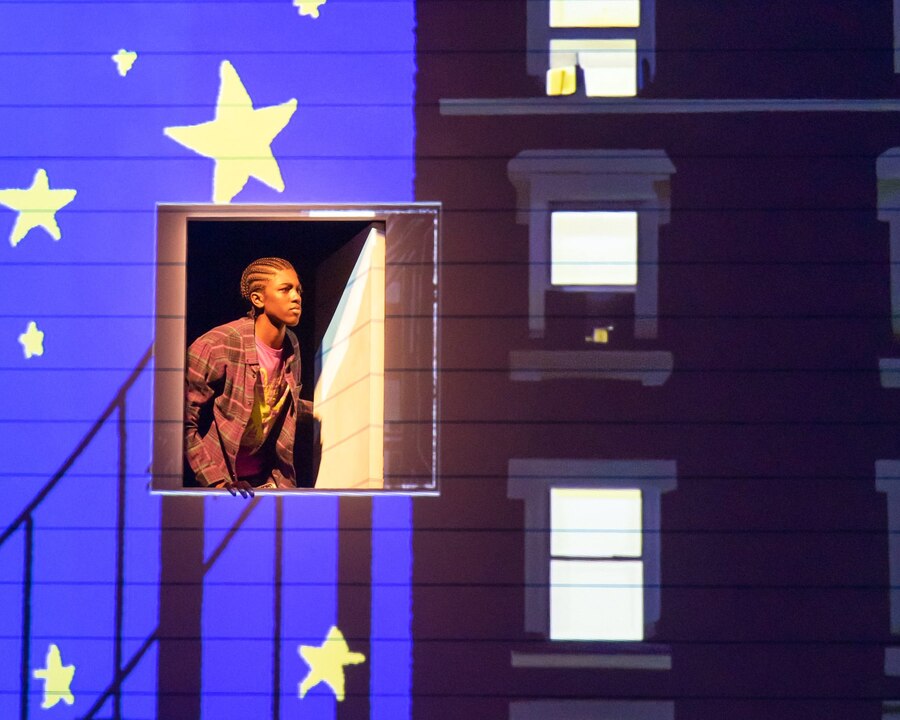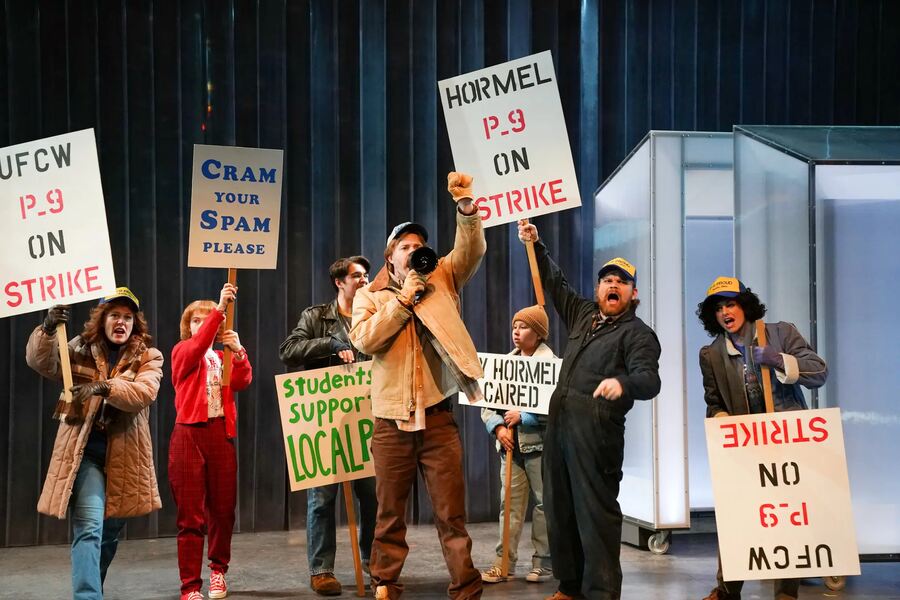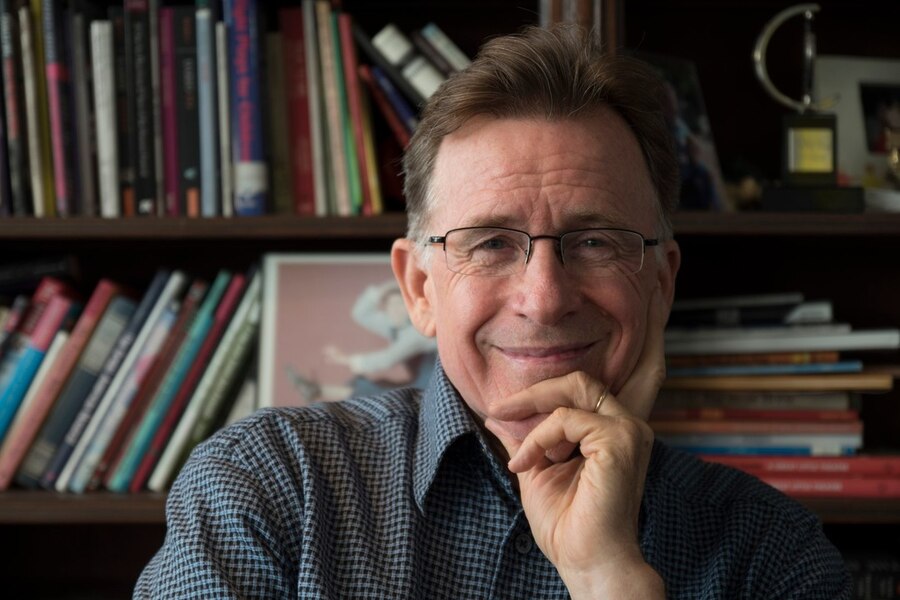The phrase “force of nature” may be over-used to describe the outsized passion of certain arts workers, but even by the high standards set by big-talking theatre people, Children’s Theatre Company artistic director Peter Brosius stands out for his boundless enthusiasm and bottomless vim. He won’t just tell you about his theatre’s upcoming season—the last he will program at the venerable company he’s led since 1997, and from which he’ll make an exit in June 2024. He’ll tell you about each show in detail, who wrote and designed it, what it has to say, why it moves him and his audiences so much. What rescues all this from mere salesmanship is that Brosius unmistakably means every word. It also matters that the product he’s pitching is high-quality theatre experiences for young people—a reliable antidote to despair if there ever was one.
Brosius comes from a theatrical family, but caught the true spark of his life’s work when he saw the groundbreaking theatre that European companies like GRIPS and Rote Grütze were making for young audiences. Like such U.S. troupes as Bloolips and El Teatro Campesino, those German companies were making “work that spoke to a community.” And so, for most his career, the community Brosius’s work has spoken to has been young people: First at the Mark Taper Forum in Los Angeles, then at Honolulu Theatre for Youth, and finally at CTC. He has doubled the Minneapolis theatre in budget size (from $6 million to $13 million) and helped it win a Regional Tony, not long after taking a show to Broadway (Robert and Willie Reale’s musical A Year With Frog and Toad, which will also close CTC’s season next year under Brosius’s direction). In the years he’s run the company, it has become a leading U.S. theatre, and not only in the field Theatre for Young Audiences (TYA), and has commissioned dozens of new works, from the artisanal to the populist, from theatremakers including Cheryl West, Nilo Cruz, Naomi Iizuka, Larissa FastHorse, Itamar Moses, Jerome Hairston, Barry Kornhauser, Lloyd Suh, Will Power, Liz Duffy Adams, Carlos Murillo, Kia Corthron, Philip Dawkins, and Greg Banks.
I spoke to Brosius recently about his past work, the precarious future of the field, and why work for young people is the key to both. This conversation has been (very) condensed for brevity and clarity.
ROB WEINERT-KENDT: Apart from your European inspirations, were there organizational models you looked to among U.S. resident theatres as CTC grew?
PETER BROSIUS: My model for a regional theatre was the Taper. That was the one I’d spent time inside of, hanging out with Gordon Davidson, going to new-play readings, developing work for the mainstage. There were things about it that worked, and there were things about it that I vowed never to do. So it was a teaching model in a multitude of ways.
What are some things you vowed to do differently?
I decided that if I was going to commission work, I was going to commission artists for a specific project, give them everything they need and keep working on it until we do it—not do new work as an audition.
Right, a lot of theatres treat commissions as auditions, as you say, but some also give them out as sort of open-ended grants, with no real expectation of production on either side.
I would never do that. When I commission work, and I’ve done a lot of plays here—70, 80, whatever—the goal is to commission someone you love. You don’t hand it out like candy. You say, “Let’s talk. I want you to write something that I’m committed to produce.” And that can take months until you find something they’re committed to and that you want to be committed to, so that you’re all in and they’re all in. We produce about 90 percent of the things we commission. Sometimes it takes longer than the playwright or I would like. But our goal is that when we finish, it’s a play that will be done across the country because it’s beautiful, it’s good, it’s impactful, the structure works.
I’ve heard folks say that TYA is all about the titles—i.e., adapting existing popular books and other IP. That conversation seems related to the practice of nonprofit theatres taking enhancement money in hopes of moving shows to Broadway. So on both the play development and the producing sides, I imagine you’ve spent a good amount of time dealing with commercial entities. How do you navigate that and stay on mission, to make sure your theatre doesn’t become a tryout house or a children’s book brand extension?
It’s actually pretty easy. Once you enter into that space, the commercial space, you’re sometimes offered things. When we won the Tony, everyone had a project for us. I’ve been offered projects that came with half a million dollars. But if I didn’t believe in the project, we didn’t do it. We’ve never, ever seen ourselves as a tryout house. We see ourselves as a place to do work that we’re passionate about, that we believe in. Because even if someone gives you half a million dollars, you’re still going to spend a lot more of your own money too. And if you don’t deeply believe in the work, if you don’t care about it and feel like it has something to say for your audience, you end up doing the same amount of work, and it’s just soul-sucking. So we’ve engaged in numerous conversations with a variety of extraordinary producers about work we thought might have a commercial life, and some of those didn’t work out, for very complicated and very unique reasons. And we’re involved in several of them right now, with folks like Bob Boyett, a complete gentleman and an honest man who cares about the work.
Navigating that space can be tricky, because it’s a huge investment of time and lawyer fees and staff time—it’s endless. And yet the team we have downstairs working on An American Tail is an extraordinary team, and it’s a project that has unbelievable currency; they’ve taken this film and dug so much deeper into it, both in terms of the immigrant experience and how we’re divided as people. And the penultimate number is perhaps one of the most beautiful songs that’s ever been on our stage. It’s a song about the promise of America and what America can be and should be. I’ve only heard it 13,000 times, and I cry every single time, because it’s so inspiring and so challenging, and so beautifully done by Mike [Maher], Alan [Schmuckler], and Itamar [Moses].
I’ve always been curious about folks who make work for young people. Like, do you actually, personally like kids?
It’s funny, because there are numerous stories of extraordinary children’s book authors who had no time whatsoever for kids—either didn’t have them or didn’t want to be around them. Like all good authors, they are mining their own experience. They were kids at one time; they know the yearnings, the isolation, the hungers. I am not those guys. I’ve been blessed to be a father, and it’s one of the joys of my life, learning from my kids. And I’ve been blessed to be around the kids here, who bring such passion, optimism, intelligence, and rigor to the work. They care so deeply and they work so hard. When you watch a young person—like recently, Talvin Wilks did a beautiful production of Jacqueline Woodson’s Locomotion, just a beautiful, elegant production, and the lead young man, who had never played a lead to my knowledge, grew each night in previews. Watching him on opening night own that stage, own that part, and bring such lucidity to and heart to it—I mean, it just fills you with joy.
I love to laugh, and kids make me laugh. When I direct, I try to create a rehearsal space that’s filled with joy and play. I’ll obviously do my homework for months and months and months. But I also hope that there’s a better idea than mine in the room. And sometimes it comes from a 9-year-old. And in these very complicated times to be a human, and particularly to be an American, I love to have their optimism—because they’re not beaten to the ground by MAGA. They are making their world, dealing with their issues, figuring out their gender identity, where they stand on critical issues. I mean, is it a tough time? Absolutely. I don’t want to be naive. But they are making the world. And that’s a) fun, and b) optimistic, and c) incredibly humbling, how smart they are.

If you hang around the business long enough, you’re gonna get asked questions like this: What’s changed the most in the 26 years since you started?
The field has changed so radically, it’s unbelievable. Our service organization, which was called Assitej USA and which they rebranded as TYA/USA, when I was first starting out, there were about five of us on the board, and there like five nickels in the bank. We met in someone’s living room. And now we have paid staff, we have annual conferences and festivals and scholarship programs. The number of purpose-built theatres across this country that serve this audience, the amount of new work that’s being generated, the attention to issues of representation—you know, the field is just night-and-day different. When I started, there were multiple foundations that had in their guidelines that they didn’t fund work for young people. So I made it a personal crusade of mine to talk to every single one of those foundations, because it’s outrageous and insulting, and ridiculous when you’re trying to build an audience for the future. That has changed radically.
You also see the number of regionals who are beginning to make multigenerational programming a part of their life, because they realize that the single best way to build the audience of the future is to start people when they’re young. It’s not gambling. It’s bloody simple. All the studies show that people who have been exposed to the arts and had deep arts experiences when they’re young are so much more likely to engage the arts as audiences, as practitioners, as donors, as patrons, as board members, as staff, than those who haven’t. So we literally see our work not so much as making plays but as sort of guaranteeing a future for the American theatre. Because if you build this audience, if you build a love for this work when people are young, if they see it and it has an impact because you work your heart out to make something good, there’s a chance they’ll come see theatre.
That’s an inspiring answer. The question I have to ask, though, is if you still feel as sanguine about the field after the challenges of the past few years. Are audiences coming back?
I mean, it is a tough time for the field. In Minnesota, you’re watching corporations move away from funding the arts, which is ridiculously short-sighted, both in terms of the communities they’re trying to create and the world they hope to espouse. You’re watching prices rise, wage demands rise, demands to work less hours, to bring in more consultants; it’s very complicated.
But there are certain things that work really well for us. People are hungry to provide opportunities for their kids, so our education programs are going gangbusters. They’re selling out faster than ever, and we have brilliant programs led by Ann Joseph-Douglas, who’s just amazing. And our Grinch this year may have been our best production ever. We had some chemistry in the cast that just lit it up, and it was the highest-grossing show in the history of the theatre. But when we put on How the Grinch Stole Christmas, we don’t stop the deep work of what that show’s about. We don’t think, “Oh, it’s a big musical, a big orchestra and fancy costumes.” No, it’s a piece about the agency of young people to change a community frightened of the outsider, finding a way to come together; it’s about the possibility of change. So our success is not just that kids are laughing their tails off because our Grinch is so funny, but that adults are weeping as they’re watching this guy try to change and he can’t. Which is the story of you and me and every person on this planet. It’s hard to change, when you’ve barricaded yourself and filled yourself with loathing and fear.
So, yes, we’ll deliver all the comedy and big fat show-stopping musical numbers, and we’ll do that really well, because we’re serious about our work. But we take every classic, every giant musical, and make it about something real. I mean, the heart that we brought in working with the various teams on Diary of a Wimpy Kid, to make something that about how, in your pursuit of popularity, you can ignore and destroy a friendship. Is it also funny as heck, with great pop songs? Yeah, we do all that. But at the core, there’s something we want people to leave with.

Does that ever edge into the didactic? Work for young people can sometimes seem like issue-oriented edutainment, and I wonder how you avoid that trap.
Part of our success is that we lean into this through the eyes of children. For whatever reason, I was obsessed by Spam, and I was also a fan of Barbara Koppel’s film, American Dream, about the Austin, Minn., strike in the ’80s at the Hormel plant, so I said, “We’ve got to do something about the Austin strike.” So we brought in Phillip Dawkins, and he did about 40 interviews with people who were kids at the time of the strike. We got all this pushback, like, Why are you picking at this wound? Why are you dealing with this? Because the reality is, it’s still tense on the ground. When you meet people in Austin, you’ll have people say, “I still won’t buy Hormel products,” 40 years later. What Philip did, though, was look at it through the eyes of the kids of the factory owners, the kids of the employees, the kids of the people who were scabs, the kids of the union folks, the kids of the people who ran a hairdressing salon in town. Not only was it a beautifully written play, but the whole town came up to see it to see themselves and to see each other, not as a scab or a union guy but as: I was 9, and as kids, this was hard. They lost friendships; it changed their lives forever. Because it’s through the lens of these young people, you’re dealing with experience rather than didacticism, rather than partisan ideas. Spamtown, USA was a gorgeous example of that.
You’re not the Grinch, Peter, but I’m wondering about your openness to change as you wind down your time at CTC.
I mean, it is bizarre. I’ve been doing this a long time. It’ll be 27 years here, two years in Hawaii, 10 years at the Taper. I’ve had a blessed, blessed, blessed career. I’ve been able to do a lot of work that I couldn’t be prouder of, and work with extraordinary artists who brought everything. I want to leave while I’m still in love with the work. I mean, I’m still in love with making work. We just finished a workshop last night of this piece that’ll be the second show of the season, Morris Micklewhite and the Tangerine Dress, with this fabulous young playwright juliany taveras, about a little boy who loves a tangerine dress; in this day and age right now, it’s a banned book, it couldn’t be done in numerous states. Just being in that room and watching these young people bring the show to life, and then sitting in on a run-through of An American Tail that’s just filled with such smart thinking and such beautiful songs…
So yeah, there are things I know that I will miss, and also there are aspects of working in the theatre right now that I’ve done for a long time and I’m willing to let go. I’m looking forward to figuring out what the next creative chapter is. I’m not the retiring type. I’m blessed right now with, knock on wood, good health and good energy and lots of hunger to make work. I’m interested in seeing, how can I contribute?
Rob Weinert-Kendt (he/him) is editor-in-chief of American Theatre.


